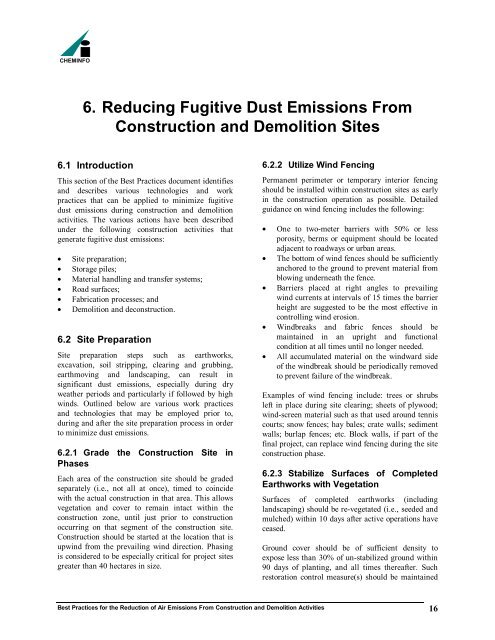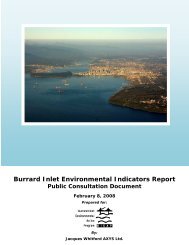Best Practices for the Reduction of Air Emissions From Construction ...
Best Practices for the Reduction of Air Emissions From Construction ...
Best Practices for the Reduction of Air Emissions From Construction ...
Create successful ePaper yourself
Turn your PDF publications into a flip-book with our unique Google optimized e-Paper software.
CHEMINFO<br />
6. Reducing Fugitive Dust <strong>Emissions</strong> <strong>From</strong><br />
<strong>Construction</strong> and Demolition Sites<br />
6.1 Introduction<br />
This section <strong>of</strong> <strong>the</strong> <strong>Best</strong> <strong>Practices</strong> document identifies<br />
and describes various technologies and work<br />
practices that can be applied to minimize fugitive<br />
dust emissions during construction and demolition<br />
activities. The various actions have been described<br />
under <strong>the</strong> following construction activities that<br />
generate fugitive dust emissions:<br />
• Site preparation;<br />
• Storage piles;<br />
• Material handling and transfer systems;<br />
• Road surfaces;<br />
• Fabrication processes; and<br />
• Demolition and deconstruction.<br />
6.2 Site Preparation<br />
Site preparation steps such as earthworks,<br />
excavation, soil stripping, clearing and grubbing,<br />
earthmoving and landscaping, can result in<br />
significant dust emissions, especially during dry<br />
wea<strong>the</strong>r periods and particularly if followed by high<br />
winds. Outlined below are various work practices<br />
and technologies that may be employed prior to,<br />
during and after <strong>the</strong> site preparation process in order<br />
to minimize dust emissions.<br />
6.2.1 Grade <strong>the</strong> <strong>Construction</strong> Site in<br />
Phases<br />
Each area <strong>of</strong> <strong>the</strong> construction site should be graded<br />
separately (i.e., not all at once), timed to coincide<br />
with <strong>the</strong> actual construction in that area. This allows<br />
vegetation and cover to remain intact within <strong>the</strong><br />
construction zone, until just prior to construction<br />
occurring on that segment <strong>of</strong> <strong>the</strong> construction site.<br />
<strong>Construction</strong> should be started at <strong>the</strong> location that is<br />
upwind from <strong>the</strong> prevailing wind direction. Phasing<br />
is considered to be especially critical <strong>for</strong> project sites<br />
greater than 40 hectares in size.<br />
6.2.2 Utilize Wind Fencing<br />
Permanent perimeter or temporary interior fencing<br />
should be installed within construction sites as early<br />
in <strong>the</strong> construction operation as possible. Detailed<br />
guidance on wind fencing includes <strong>the</strong> following:<br />
• One to two-meter barriers with 50% or less<br />
porosity, berms or equipment should be located<br />
adjacent to roadways or urban areas.<br />
• The bottom <strong>of</strong> wind fences should be sufficiently<br />
anchored to <strong>the</strong> ground to prevent material from<br />
blowing underneath <strong>the</strong> fence.<br />
• Barriers placed at right angles to prevailing<br />
wind currents at intervals <strong>of</strong> 15 times <strong>the</strong> barrier<br />
height are suggested to be <strong>the</strong> most effective in<br />
controlling wind erosion.<br />
• Windbreaks and fabric fences should be<br />
maintained in an upright and functional<br />
condition at all times until no longer needed.<br />
• All accumulated material on <strong>the</strong> windward side<br />
<strong>of</strong> <strong>the</strong> windbreak should be periodically removed<br />
to prevent failure <strong>of</strong> <strong>the</strong> windbreak.<br />
Examples <strong>of</strong> wind fencing include: trees or shrubs<br />
left in place during site clearing; sheets <strong>of</strong> plywood;<br />
wind-screen material such as that used around tennis<br />
courts; snow fences; hay bales; crate walls; sediment<br />
walls; burlap fences; etc. Block walls, if part <strong>of</strong> <strong>the</strong><br />
final project, can replace wind fencing during <strong>the</strong> site<br />
construction phase.<br />
6.2.3 Stabilize Surfaces <strong>of</strong> Completed<br />
Earthworks with Vegetation<br />
Surfaces <strong>of</strong> completed earthworks (including<br />
landscaping) should be re-vegetated (i.e., seeded and<br />
mulched) within 10 days after active operations have<br />
ceased.<br />
Ground cover should be <strong>of</strong> sufficient density to<br />
expose less than 30% <strong>of</strong> un-stabilized ground within<br />
90 days <strong>of</strong> planting, and all times <strong>the</strong>reafter. Such<br />
restoration control measure(s) should be maintained<br />
<strong>Best</strong> <strong>Practices</strong> <strong>for</strong> <strong>the</strong> <strong>Reduction</strong> <strong>of</strong> <strong>Air</strong> <strong>Emissions</strong> <strong>From</strong> <strong>Construction</strong> and Demolition Activities 16
















